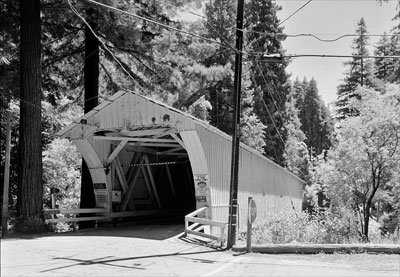National Register of Historic Places in Santa Cruz County
California Powder Works Bridge
Keystone Way Over San Lorenzo River
Paradise Park
Built 1872
The discovery of gold in California in 1848 created a growing demand for blasting powder for mining and railroad construction. Powder imported from the East Coast was expensive and often of diminished quality from long sea voyages. When the Civil War threatened to eliminate the supply of blasting powder altogether, a group of San Francisco businessmen formed the California Powder Works in 1861.
In 1862, the company purchased a site on the San Lorenzo River. The location offered water power, timber (for charcoal and kegs and fuel), proximity to transportation, a labor force, and relative seclusion for safety.
In 1863, California Powder Works built twenty-five buildings in Powder Mill Canyon. The company expanded in 1867 and again in 1872 when the covered bridge was assembled across the San Lorenzo River.
By 1879, the site contained approximately seventy-five buildings, including twenty-one powder mills, ten shops, ten wheelhouses, six magazines, a boarding house, and a school. Eventually, a village of about one hundred residents occupied a site south of the manufactory.
By 1887, California Powder Works yielded four million pounds of powder annually. It was the largest producer of explosives west of the Mississippi River for half a century.
In 1903, the Dupont Corporation purchased controlling interest and changed the name from California Powder Works to E. I. DuPont de Nemours Powder Company.
In 1912, DuPont holdings were broken up under the Sherman Antitrust Act. The powder company was reorganized as the Hercules Powder Company and moved to a modern facility at Hercules where operations continued until 1955.
Source: Adapted from the NRHP nomination submitted in 2015.

In 1872, the bridge was fabricated at a Pacific Bridge company plant in Alameda, shipped by rail, then transported by wagon to the site. At the time of its construction, the Powder Works Bridge was the longest single-span bridge in Santa Cruz County and was sturdy enough to accommodate the narrow-gauge railway spur that carried horse-drawn cars of charcoal from the kilns on the east side of the river to the powder works on the west side of the river.
The bridge is an excellent example of a Smith truss, a timber design that was light, strong and efficient. For a short time, this design allowed wooden bridges to compete with iron bridges as an industrial product. Only twenty-three historic examples survive.
Source: Adapted from the NRHP nomination submitted in 2015.

In 1924, members of the Fresno Masonic fraternity purchased the property for use as a summer cottage colony. They renamed the site Paradise Park.
As the years passed, residents winterized their homes. Today, Paradise Park is a year-round residential community of approximately two hundred households. A few visible remnants of the former California Powder Works complex remain, most notably the covered bridge.
Source: Adapted from the NRHP nomination submitted in 2015.

Because the bridge is located in a gated community, we could not photograph it.

Bridgeport
California Powder Works Bridge
Felton
Glen Canyon
Honey Run
Knights Ferry
Oregon Creek
Wawona
Zane's Ranch
Historic Covered Bridges in Oregon
Antelope Creek
Grave Creek
Little Butte Creek
Lost Creek
